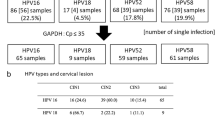Abstract
Background
Numerous studies have been performed to discover predictive/prognostic biomarkers for human papillomavirus (HPV) infection and cervical cancer development. More recently, microRNAs were suggested as possible biomarkers of HPV-associated cancers and our aim was to characterize the expression of let-7c in exfoliated cervical cells from women with cervical intraepithelial lesions.
Methods
Let-7c expression was evaluated by quantitative reverse transcription-polymerase chain reaction in 73 women with normal or cervical intraepithelial lesions: normal epithelium with (n = 17) and without (n = 21) HPV infection; low-grade squamous intraepithelial lesions (n = 14); and high-grade squamous intraepithelial lesions (n = 21).
Results
Data showed a trend to down-regulation in women with low-grade squamous intraepithelial lesions (2−ΔΔCt = 0.38, p = 0.06) and a significant decreased expression of let-7c in women with low-grade squamous intraepithelial lesions (2−ΔΔCt = 0.21; p = 0.004). The combined analysis of all cervical intraepithelial lesions revealed a down-regulation of let-7c expression (2−ΔΔCt = 0.27; p = 0.011).
Conclusion
Our results showed that let-7c expression is significantly changed in the different cervical intraepithelial lesions and its levels should be further investigated as a possible biomarker for cervical intraepithelial lesions using exfoliated cervical cells as the sample source.

Similar content being viewed by others
References
Ferlay J, Soerjomataram I, Ervik M, Dikshit R, Eser S, Mathers C, Rebelo M, Parkin DM, Forman D, Bray F. GLOBOCAN 2012 v1.0, cancer incidence and mortality worldwide: IARC CancerBase No. 11. 2013. http://globocan.iarc.fr. Accessed 29 Jan 2014.
zur Hausen H. Papillomaviruses in human cancer. Cancer. 1987;59(10):1692–6.
Juckett G, Hartman-Adams H. Human papillomavirus: clinical manifestations and prevention. Am Family Phys. 2010;82(10):1209–13.
Hwang SJ, Shroyer KR. Biomarkers of cervical dysplasia and carcinoma. J Oncol. 2012;2012:507286.
Woodman CB, Collins SI, Young LS. The natural history of cervical HPV infection: unresolved issues. Nature Rev Cancer. 2007;7(1):11–22.
Yim EK, Park JS. Biomarkers in cervical cancer. Biomark Insights. 2007;1:215–25.
Pereira PM, Marques JP, Soares AR, Carreto L, Santos MA. MicroRNA expression variability in human cervical tissues. PLoS One. 2010;5(7):e11780.
Zheng ZM, Wang X. Regulation of cellular miRNA expression by human papillomaviruses. Biochim Biophys Acta. 2011;1809(11–12):668–77.
Calin GA, Sevignani C, Dumitru CD, Hyslop T, Noch E, Yendamuri S, et al. Human microRNA genes are frequently located at fragile sites and genomic regions involved in cancers. Proc Natl Acad Sci USA. 2004;101(9):2999–3004.
Lui WO, Pourmand N, Patterson BK, Fire A. Patterns of known and novel small RNAs in human cervical cancer. Cancer Res. 2007;67(13):6031–43.
Ma D, Zhang YY, Guo YL, Li ZJ, Geng L. Profiling of microRNA-mRNA reveals roles of microRNAs in cervical cancer. Chinese Med J. 2012;125(23):4270–6.
Nuovo GJ, Wu X, Volinia S, Yan F, di Leva G, Chin N, et al. Strong inverse correlation between microRNA-125b and human papillomavirus DNA in productive infection. Diagn Mol Pathol. 2010;19(3):135–43.
Koeneman MM, Kruitwagen RF, Nijman HW, Slangen BF, Van Gorp T, Kruse AJ. Natural history of high-grade cervical intraepithelial neoplasia: a review of prognostic biomarkers. Expert Rev Mol Diagn. 2015;15(4):527–46.
Lu J, Getz G, Miska EA, Alvarez-Saavedra E, Lamb J, Peck D, et al. MicroRNA expression profiles classify human cancers. Nature. 2005;435(7043):834–8.
Chen PS, Su JL, Hung MC. Dysregulation of microRNAs in cancer. J Biomed Sci. 2012;19:90.
Johnson CD, Esquela-Kerscher A, Stefani G, Byrom M, Kelnar K, Ovcharenko D, et al. The let-7 microRNA represses cell proliferation pathways in human cells. Cancer Res. 2007;67(16):7713–22.
Ozen M, Creighton CJ, Ozdemir M, Ittmann M. Widespread deregulation of microRNA expression in human prostate cancer. Oncogene. 2008;27(12):1788–93.
Zhao H, Shen J, Medico L, Wang D, Ambrosone CB, Liu S. A pilot study of circulating miRNAs as potential biomarkers of early stage breast cancer. PLoS One. 2010;5(10):e13735.
Boominathan L. The tumor suppressors p53, p63, and p73 are regulators of microRNA processing complex. PLoS One. 2010;5(5):e10615.
Tarasov V, Jung P, Verdoodt B, Lodygin D, Epanchintsev A, Menssen A, et al. Differential regulation of microRNAs by p53 revealed by massively parallel sequencing: miR-34a is a p53 target that induces apoptosis and G1-arrest. Cell Cycle. 2007;6(13):1586–93.
Acknowledgments
The authors acknowledge Inês Baldaque (MD) from the Virology Service of the Portuguese Institute of Oncology of Porto for access to clinical and laboratorial data.
Author contributions
MM and JR were responsible for the experimental tests, data analysis, and manuscript writing; JR and HS were responsible for the experimental design; PM and JL were responsible for the clinical data of cases; RM was responsible for the study supervision; and HS was responsible for the study outline, data collection, and manuscript revision. All authors provided critical reviews and revisions of the manuscript.
Conflicts of interest
All authors declare no conflict of interest.
Author information
Authors and Affiliations
Corresponding author
Additional information
M. Malta and J. Ribeiro participated equally in the study.
Electronic supplementary material
Below is the link to the electronic supplementary material.
40291_2015_145_MOESM1_ESM.tiff
Supplementary Fig. 1. ROC curve for Let-7c and high-grade intraepithelial lesion detection. AUC area under the plasma concentration time curve, ROC receiver operating characteristic (TIFF 1018 kb)
Rights and permissions
About this article
Cite this article
Malta, M., Ribeiro, J., Monteiro, P. et al. Let-7c is a Candidate Biomarker for Cervical Intraepithelial Lesions: A Pilot Study. Mol Diagn Ther 19, 191–196 (2015). https://doi.org/10.1007/s40291-015-0145-4
Published:
Issue Date:
DOI: https://doi.org/10.1007/s40291-015-0145-4




